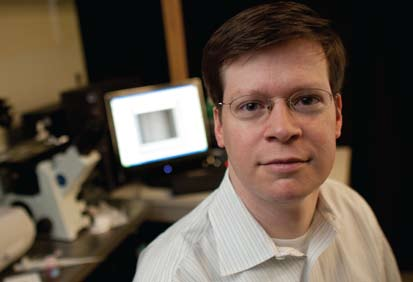Imagine this task: You must cover a football field with millions of tiny tiles, placing each in an assigned position. Would you rather install each tile by hand, or throw all the tiles in the air and hope each lands in its proper spot?
James Gilchrist ponders this scenario as he studies particles that self-organize in materials and devices. He and his group explore the surface dynamics of the “coffee ring effect,” in which particles from a drop of coffee spilled on a white table travel to the edge of the spill and form a ring.
Gilchrist, the P.C. Rossin Assistant Professor of chemical engineering, says if you can control the fluid, surface and particle properties of a drop of liquid, and if you can control the process by which the liquid is pulled across a particle, you can cause particles to self-organize as they dry.
For example, Gilchrist works with Prof. Xuanhong Cheng of materials science and engineering on a portable device that monitors HIV infection. His goal is to change the properties of tiny particles of polystyrene-coated iron oxide so they stick to infected cells in a blood sample, thus helping doctors assess the level of infection.
Gilchrist also collaborates with Prof. Nelson Tansu of electrical and computer engineering to maximize LED efficiency. Light-emitting diodes, used in computers and eventually in ultra-efficient lightbulbs, can be improved by allowing more photons to escape from the surface of an LED and thereby create light. Gilchrist’s team is self-assembling microlenses on the surface of the LED, which widens the escape cone and lets more photons out.
“My research focuses on the fundamental processes by which particles are deposited on surfaces,” says Gilchrist. “Right now it’s leading to better LEDs or BioMEMS devices. Tomorrow we hope it will enable a generation of materials and devices we haven’t even envisioned.”

